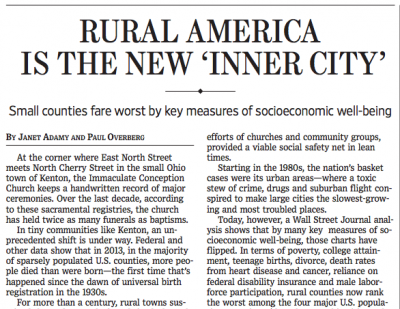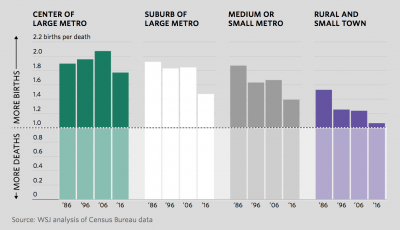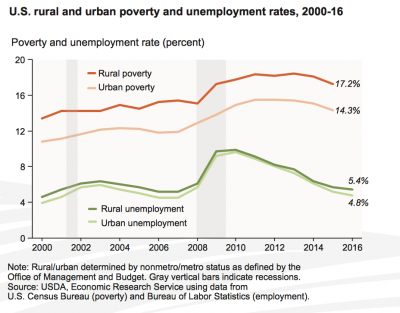Beef prices are projected to continue increasing as U.S. beef production declines with no signs of a cattle herd rebuild. Additionally, cheap beef may soon become further out of reach…
Wall Street Journal Looks at Rural America, “The New ‘Inner City'”
Janet Adamy and Paul Overberg reported on the front page of Saturday’s Wall Street Journal that, “At the corner where East North Street meets North Cherry Street in the small Ohio town of Kenton, the Immaculate Conception Church keeps a handwritten record of major ceremonies. Over the last decade, according to these sacramental registries, the church has held twice as many funerals as baptisms.
“In tiny communities like Kenton, an unprecedented shift is under way. Federal and other data show that in 2013, in the majority of sparsely populated U.S. counties, more people died than were born—the first time that’s happened since the dawn of universal birth registration in the 1930s.”

Saturday’s article noted that, “Starting in the 1980s, the nation’s basket cases were its urban areas—where a toxic stew of crime, drugs and suburban flight conspired to make large cities the slowest-growing and most troubled places.
“Today, however, a Wall Street Journal analysis shows that by many key measures of socioeconomic well-being, those charts have flipped. In terms of poverty, college attainment, teenage births, divorce, death rates from heart disease and cancer, reliance on federal disability insurance and male labor-force participation, rural counties now rank the worst among the four major U.S. population groupings (the others are big cities, suburbs and medium or small metro areas).”

Adamy and Overberg stated in their article that:
Just two decades ago, the onset of new technologies, in particular the internet, promised to boost the fortunes of rural areas by allowing more people to work from anywhere and freeing companies to expand and invest outside metropolitan areas. Those gains never materialized.
The Journal article noted that, “As jobs in manufacturing and agriculture continue to vanish, America’s heartland faces a larger, more existential crisis. Some economists now believe that a modern nation is richer when economic activity is concentrated in cities.”
“In Hardin County, where Kenton is the seat, factories that once made cabooses for trains and axles for commercial trucks have shut down. Since 1980, the share of county residents who live in poverty has risen by 45% and median household income adjusted for inflation has fallen by 7%,” Saturday’s article said.
“At the same time, census figures show, the percentage of adults who are divorced has nearly tripled, outpacing the U.S. average. Opioid abuse is also driving up crime.”
Meanwhile, the Journal article explained that, “Starting in the late 1990s, Amazon.com Inc. began opening fulfillment centers in sparsely populated states to help customers avoid sales taxes. One of those centers, established in 1999, brought hundreds of jobs to Coffeyville, Kan.—population 9,500.
“Yet as two-day shipping became a priority, Amazon shifted its warehousing strategy to be closer to cities where its customers were concentrated, and shut the Coffeyville center in 2015.”
“Just as Amazon closed down, so did the century-old hospital in nearby Independence, population 8,700.”

Adamy and Overberg also pointed out that, “There has long been a wage gap between workers in urban and rural areas, but the recession of 2007-09 caused it to widen. In densely populated labor markets (with more than one million workers), [Enrico Moretti, a professor of economics at the University of California, Berkeley, who has studied the new urban-rural divide] found that the average wage is now one-third higher than in less-populated places that have 250,000 or fewer workers—a difference 50% larger than it was in the 1970s.
“As employers left small towns, many of the most ambitious young residents packed up and left, too. In 1980, the median age of people in small towns and big cities almost matched. Today, the median age in small towns is about 41 years—five years above the median in big cities. A third of adults in urban areas hold a college degree, almost twice the share in rural counties, census figures show.”

The general condition of the U.S. rural economy has additional potential implications for farm household income.
A paper from December, by Iowa State University professor David Peters, indicated that, “A struggling farm economy only highlights the need for non-farm employment opportunities for all farm families. Middle-skill and middle-wage jobs are the key underpinnings of a strong non-farm rural economy in Iowa. These include traditional ‘blue collar’ industries like manufacturing, construction, transportation, and utilities; but also some ‘white collar’ sectors like healthcare and education that employ many middle-skill professionals. Economic development programs should focus on the recruitment, expansion, and retention of these firms; and workforce programs should target training to jobs in these industries.
The fortunes of both smaller family farms and mid-size commercial ones are closely linked to the non-farm rural economy, making rural economic development a priority for the state.
And, at Thursday’s Senate Agriculture Committee hearing on the farm economy, Oregon State University Professor Bruce Weber reminded the Committee that:
Farm household well-being is very dependent on rural community prosperity. Most farm households earn the majority of their income off the farm.
Prof. Weber explained that, “Rural economics literature offers two important conclusions:
“(1) Healthy rural communities are important for both rural and urban people in this nation, and the well-being of farm households is directly affected by the infrastructure and jobs available in their rural communities.
“(2) Federal rural development investments of the kind made through the Farm Bill (in utilities, broadband, small businesses, for example) have enhanced employment and reduced poverty in rural communities.”
Prof. Weber added that, “Farm prosperity, rural community vitality and urban prosperity have become tightly linked, as farm households have become more dependent on off-farm income and as rural and urban areas have become more interdependent.”

“For the 85 percent of U.S. farms that are small family farms, with less than $350,000 in sales, the Economic Research Service/USDA estimates that, ‘Virtually all of these farms’ income comes from off-farm wage/salary jobs and unearned income (dividends, interest, rent, Social Security, other public programs, private pensions, etc.) rather than farm or off-farm self- employment.’ Even the largest farms have substantial off-farm income. Overall, ‘wages from off-farm jobs accounted for more than half of off-farm income across all farm households.'”





